Digital Poster
Electro-Magnetic Tissue Properties II
ISMRM & ISMRT Annual Meeting & Exhibition • 10-15 May 2025 • Honolulu, Hawai'i

 |
Computer Number: 81
3422. Mitigation
of Artefacts caused by the Transceive Phase Assumption in
Electrical Properties Tomography
U. Katscher, T. Meerbothe, S. Mandija, C. van den Berg, C.
Findeklee
Philips Innovative Technologies, Hamburg, Germany
Impact: The presented simple approach is able to
increase the accuracy of electric conductivity reconstructed
with “Electrical Properties Tomography” (EPT), and thus,
might help to enable EPT as clinically relevant diagnostic
tool.
|
|
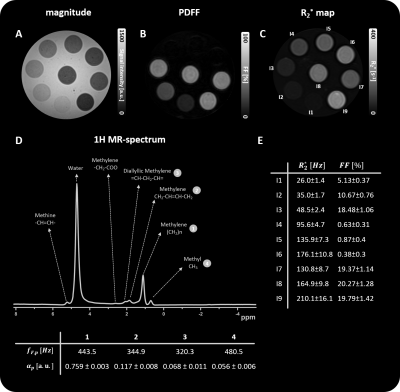 |
Computer Number: 82
3423. Navigating
Fat-Iron Interactions in QSM: Why Post-Processing Approach
Selection Matters
S. Graf, J. Trapp, M. Rothe, A. Gussew, W. Wohlgemuth, A.
Deistung
University Hospital Halle (Saale), Halle (Saale), Germany
Impact: The present study continues the investigations
into the use of quantitative susceptibility mapping in
abdominal regions, focusing on effects of adipose tissue and
iron on MR phase and susceptibility, while emphasizing the
importance of choosing appropriate data processing
techniques.
|
|
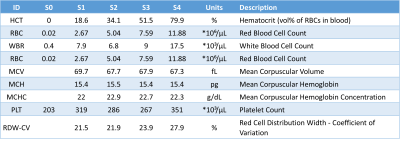 |
Computer Number: 83
3424. Blood
as a Biological Model for MREPT: A Realistic Approach to Mimic
Tissue Electrical Properties
P. Loureiro de Sousa, J. Lamy, M. Antal
ICube, Université de Strasbourg-CNRS, Strasbourg, France
Impact: Blood-based models for MR-based electrical
properties mapping enhance the realism of phantoms,
facilitating the evaluation of conductivity in heterogeneous
biological tissues. This study validates blood as a
versatile model system, enabling non-invasive analysis of
microscopic structures in vivo.
|
|
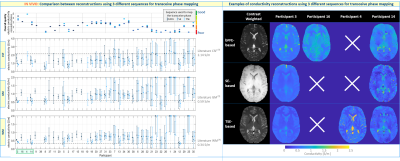 |
Computer Number: 84
3425. First
MR Electrical Properties Tomography reconstruction challenge:
phase 3 - conductivity reconstructions from measured data
S. Mandija, A. Arduino, C. van den Berg, P. Fuchs, I.
Giannakopoulos, Y. Z. Ider, K-J Jung, U. Katscher, D-H Kim,
R. Lattanzi, T. Meerbothe, K. K. Tha, L. Zilberti
University Medical Center Utrecht, Utrecht, Netherlands
Impact: The results of phase 3 of the first MR-EPT
reconstruction challenge show large variations in the
estimated conductivity maps from measured data on phantoms
and volunteer demonstrating the need of benchmarking
reconstruction methods on common datasets.
|
|
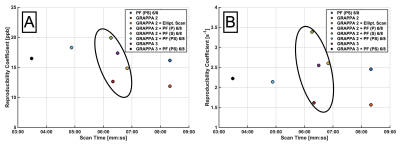 |
Computer Number: 85
3426. Implications
of Undersampling Strategy for GRAPPA-accelerated QSM and R2* Map
Acquisition
A. Jaffray, C. Kames, A. Rauscher, C. Birkl
University of British Columbia, Vancouver, Canada
Impact: Strict utilization of acceleration strategies
that do not rely on Partial Fourier acquisition can improve
QSM accuracy, and remove ambiguity in protocol design.
|
|
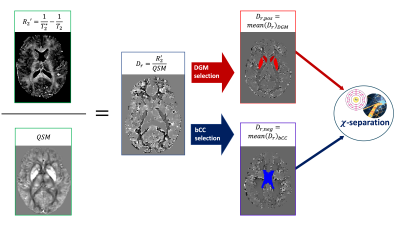 |
Computer Number: 86
3427. Integrating
a negative relaxometric constant in the χ-separation model
improves the correlation between χ negative and myelin metrics
E. Grosso, A. Ricciardi, E. Lupi, M. Yiannakas, F. Prados,
B. Kanber, E. D'Angelo, C. Gandini Wheeler-Kingshott, F.
Palesi
University of Pavia, Pavia, Italy
Impact:
The integration of a physiologically plausible negative relaxometric constant in the χ-separation model will impact on how we assess the presence of positive and negative magnetic susceptibility sources in the brain, i.e. iron and myelin. |
|
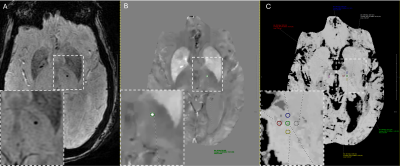 |
Computer Number: 87
3428. Assessing
Metabolic Dysfunction at Cerebral Microbleed Sites using
Quantitative Oxygen Extraction Fraction MRI
D. Zlatopolsky, I. Hagger, D. Hsu, N. Kurt, J. Cho, S. Soman
Medical College of Georgia Augusta University/ University of Georgia Medical Partnership, Augusta, United States
Impact: CMB site decreased metabolic activity that
worsens with increasing susceptibility suggests neurological
functional damage occurrence, therapeutic targets focusing
on restoring metabolic function, research directions into
how CMBs disrupt local metabolism, and that QSM may serve as
a biomarker for neurodegeneration.
|
|
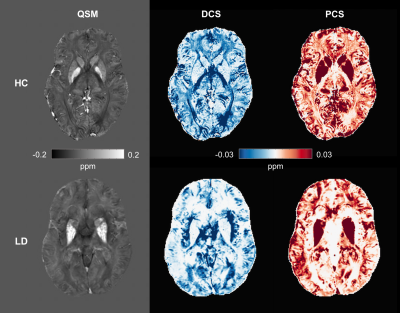 |
Computer Number: 88
3429. Patterns
of iron load and myelination in deep gray matter nuclei in
leukodystrophies revealed by DECOMPOSE-QSM
M. Lancione, M. Cencini, B. Buchignani, R. Pasquariello, D.
Montanaro, C. Liu, R. Battini, L. Biagi, M. Tosetti
IRCCS Stella Maris Foundation, Pisa, Italy
Impact: QSM and DECOMPOSE-QSM provide information on
neurodegeneration in deep gray matter nuclei in
leukodystrophies potentially identifying disease-specific
patterns and aiding the diagnostic process. Importantly,
these techniques rely on standard clinical sequences and
have short scan time, facilitating their clinical
deployment.
|
|
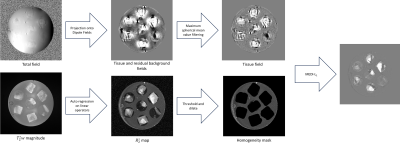 |
Computer Number: 89
3430. xvQSM:
An Open-Source Artifact Mitigation Method for ex vivo
Quantitative Susceptibility Mapping
A. Roberts, A. Dimov, M. Sisman, A. Deng, C. Skudin, H.
Zhuang, I. Kovanlikaya, P. Spincemaille, T. Nguyen, K.
Gillen, Y. Wang
Cornell University, New York, United States
Impact: The presented method mitigates ex
vivo artifacts to increase confidence in validation.
High structural similarity is observed from whole region of
interest filtering and homogeneity regularization. This
open-source pipeline improves source separation and
potentially myelin mapping, and oxygen extraction fraction.
|
|
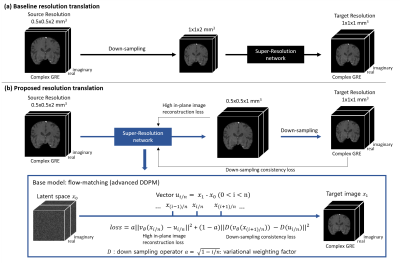 |
Computer Number: 90
3431. Resolution
translation for GRE using super-resolution network
J. Park, J. Yoon, M. Kim, B. Moon, J. Lee
Seoul National University, Seoul, Korea, Republic of
Impact: The proposed resolution translation successfully
generated high-quality complex GRE images for the isotropic
resolution, resulting in high-quality QSM, outperforming the
conventional approaches.
|
|
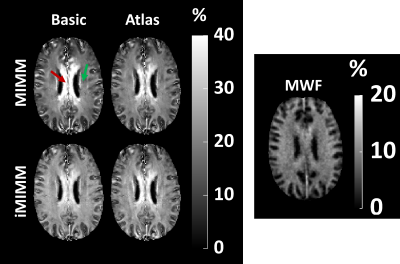 |
Computer Number: 91
3432. Improved
Microstructure-Informed Myelin Mapping (iMIMM) for Myelin
Mapping solely from Gradient-Echo Data
M. Sisman, A. Dimov, P. Spincemaille, T. Nguyen, Y. Wang
Cornell University, New York, United States
Impact: By accurate modeling of the effect of white
matter anisotropic susceptibility on the full gradient-echo
signal, myelin content can be mapped from routine gradient
echo acquisitions.
|
|
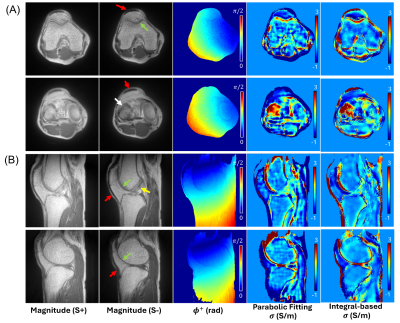 |
Computer Number: 92
3433. Ultrashort
Echo Time Quantitative Conductivity Mapping (UTE-QCM) in The
Knee: A Feasibility Study
J. Park, S. Sedaghat, E. Fu, Y. Jung, H. Jang
University of California, Davis, Sacramento, United States
Impact: UTE-QCM has the potential to provide a new
quantitative imaging tool targeting short T2 tissues
in the MSK system, facilitating the diagnosis and prognosis
of joint disorders such as osteoarthritis and tumors such as
osteosarcoma.
|
|
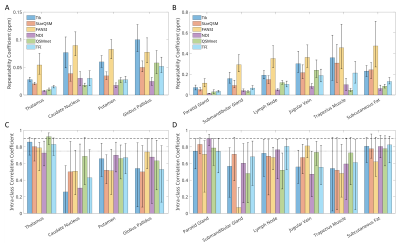 |
Computer Number: 93
3434. Comparing
Repeatability Metrics for Quantitative Susceptibility Mapping in
the Head and Neck
M. Cherukara, K. Shmueli
University College London, London, United Kingdom
Impact: This study shows that the repeatability of QSM
in the head and neck depends strongly on the dipole
inversion method used. Metrics like repeatability
coefficient and intraclass correlation coefficient offer the
most utility for comparisons between methods.
|
|
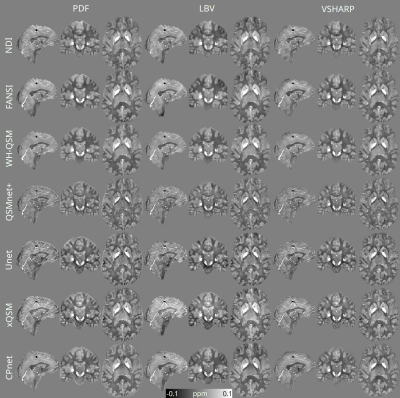 |
Computer Number: 94
3435. Performance
and Sensitivity of QSM Deep Learning algorithm to Background
Field residuals using a Realistic Numerical Head Phantom
C. Milovic, M. Lambert, C. Tejos
Pontificia Universidad Catolica de Chile, Santiago, Chile
Impact: This study highlights the limitations of current
Deep Learning-based QSM algorithms in handling residual
background fields, suggesting a need for improved training
strategies. It provides insights into which methods offer
more reliable susceptibility maps, guiding future QSM
development and applications.
|
|
 |
Computer Number: 95
3436. Does
Phase-Based EPT with a Noise-Robust Method Provide Similar
Results for GRE and bSSFP Acquisitions?
O. Arsenov, J. Luo, K. Shmueli
University College London, London, United Kingdom
Impact: Using the noise-robust MagSeg method for
phase-based EPT in GRE and bSSFP acquisitions provided
similar high-quality conductivity maps. This performance for
the ‘gold-standard’ bSSFP acquisition provides validation of
this method and a basis for a wide range of applications.
|
|
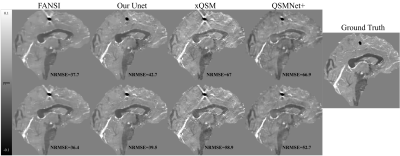 |
Computer Number: 96
3437. Precision
with Simplicity: Refining Susceptibility maps with minimal
iterative effort
M. Lambert, C. Milovic
Pontificia Universidad Católica de Chile, Santiago, Chile
Impact: This study’s refinement method for QSM could
empower clinicians with higher-quality susceptibility maps,
improving diagnostic accuracy in neurological assessments.
It encourages further exploration of minimal-iteration
techniques, promoting efficient approaches to enhance
imaging fidelity without intensive computational resources.
|
The International Society for Magnetic Resonance in Medicine is accredited by the Accreditation Council for Continuing Medical Education to provide continuing medical education for physicians.